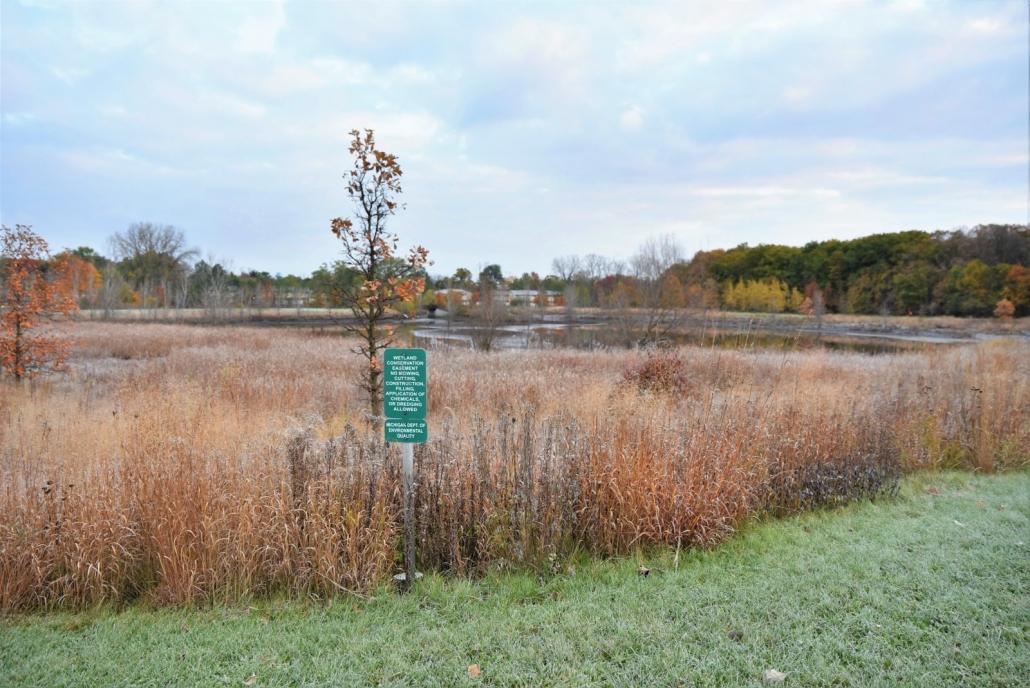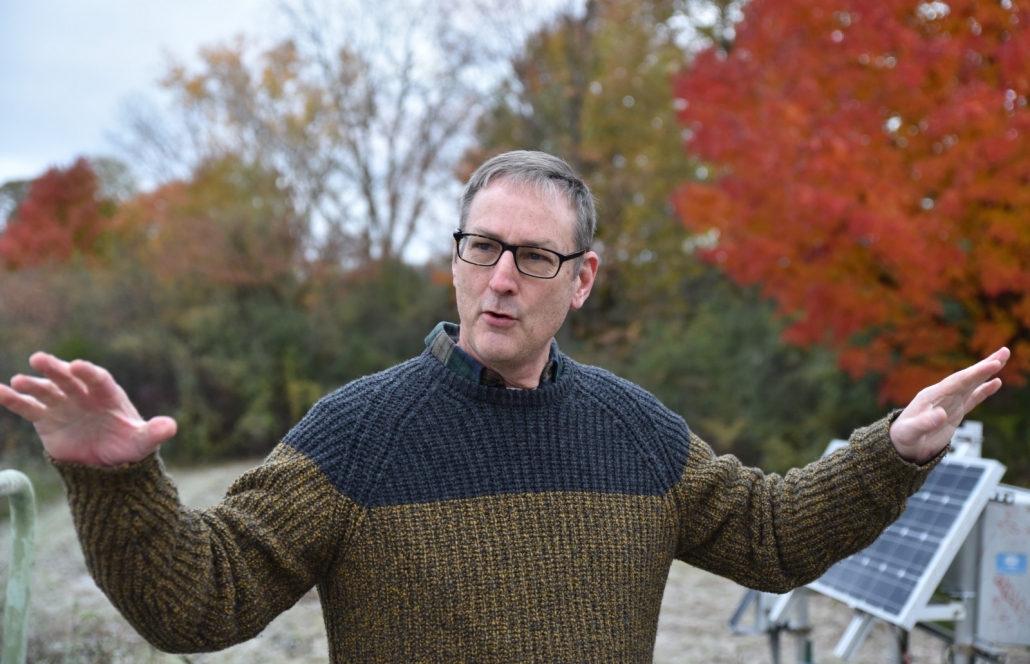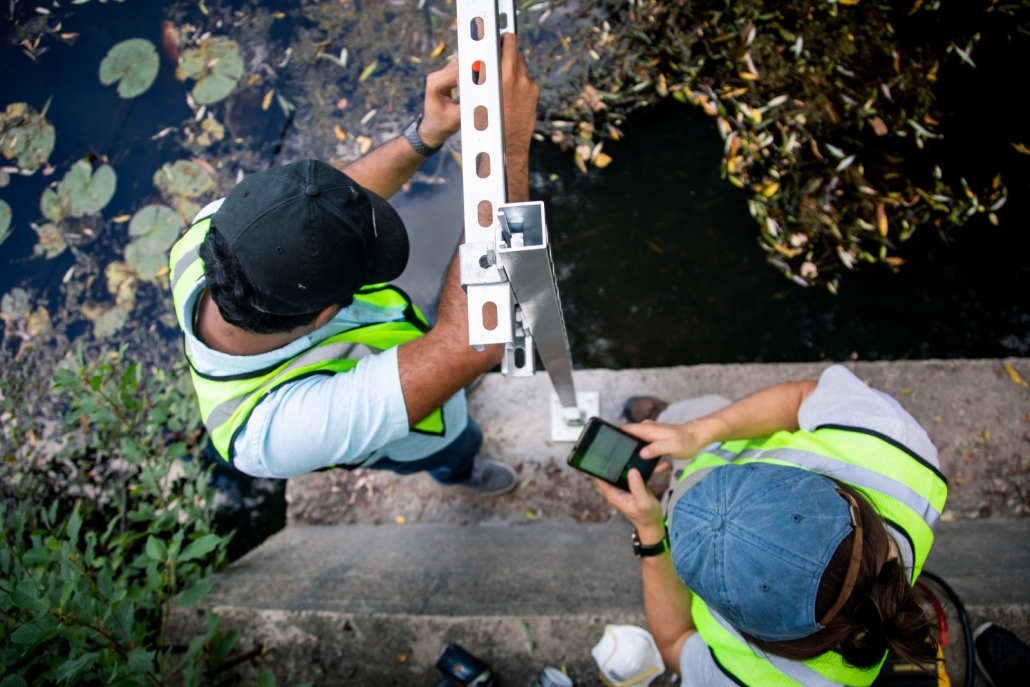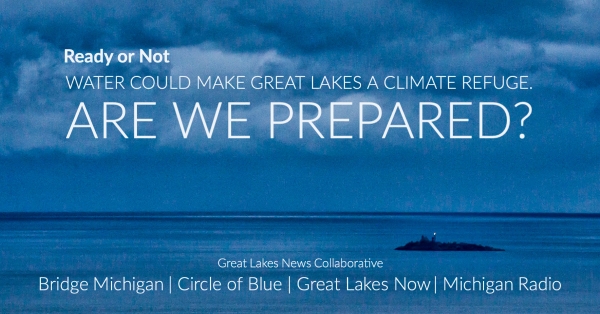
This pond at Mary Beth Doyle Park in Ann Arbor is one of a series of retention
basins that slow the rush of water and allow the stuff washed from parking lots
and streets to settle out before the water goes into the Huron River. Photo © Lester Graham, Michigan Radio.
Lester Graham, Michigan Radio, – November 11, 2021
In areas where floods were once rare, now some neighborhoods are flooding repeatedly. Stormwater sewers are being overwhelmed by more intense storms.
Most of the solutions call for big pipes and expensive construction.
A group of researchers is instead helping cities use their current systems better.
There’s an app for that.
The idea behind the research is fairly simple. Even when there’s a lot of rain, there are parts of a combined stormwater and sanitary sewer system that aren’t full. There is storage capacity. The problem is you have to know where.
The answer is going to be different for every system.
“Some places are dealing with very sort of large scale flooding, while others are dealing with water quality impairments. Here in the Great Lakes region, we have a confluence of those,” said Branko Kerkez, an Associate Professor leading a group of Ph.D. students from the University of Michigan’s College Civil and Environmental Engineering.
You’ve heard of self-driving cars. They are engineering self-operating sewer systems.
Kerkez says a rainstorm doesn’t hit a city the same way everywhere at the same time.
“So a good example is it’s raining a lot on one part of town, it’s not raining that much in another part of town, so you might have storage assets that are not full all the time,” Kerkez explained.
He and his team have been experimenting with cheap monitors that are hooked to the internet. By looking at a computer screen or even a phone, sewer system operators can see what’s going on.
“What are the conditions? Do I have extra storage over here? Can I close that valve to allow another part of the system to drain out? Just like a car that self-driving steers itself. Given changing conditions, water systems in the future may be able to control themselves dynamically in response to these inputs,” Kerkez said.
The Washtenaw County Water Resources Commission has been working with Kerkez and his team. Harry Sheehan is the Chief Deputy Water Resources Commissioner.
On a recent chilly morning he showed me ponds where some of the monitors were used.

Harry Sheehan, Chief Deputy Water Resources Commissioner for
Washtenaw County, explains how remote technology is helping to design better stormwater systems. Photo © Lester Graham, Michigan Radio.
“This cost $500, you can plunk them down anywhere, right, and it’s got a solar panel and it’s got a modem in it, so it can tell you what the levels of water are very quickly. So, you know, it’s cheap, it’s low maintenance, it gives you lots of information,” Sheehan said.
For Washtenaw County, the sensors are helping to identify where there are choke points. They can install the monitors in storage ponds and a creek that connects them. After a couple of years, they’ve gathered lots of data about how the creek and ponds behave during heavy storms.
“And when we hire an engineering consultant to do a modeling to see what can be done there and what the design should look like. They already have the data. Right. So you’ve already collected $30,000 worth of data for a few hundred bucks,” Sheehan said.
That’s going to help Washtenaw County figure out how to better manage stormwater and save some money.
Sheehan noted even the water soaking into the ground in rain gardens can be monitored to see if they’re working well.
In a system such as Washtenaw County, much of the stormwater runoff goes to rain gardens and ponds like the ones we visited.
Most of those ponds were excavated in the 1960s and 70s. Not a lot of thought was given to the aesthetics. A collaborator with Kerkez and his team finds that acceptance of a smart stormwater system by the public depends on whether it seems to fit in the neighborhood.
“How the edge of the smart stormwater pond appears. And that’s affected by the steepness of the slope for contructing the pond, as well as how much edge there is beyond that slope that has water in it, where you can plant and what kinds of plantings are there,” explained Joan Nassauer, Professor in the School for Environment and Sustainability at the University of Michigan. She conducted surveys of in cities with and without smart stormwater systems.
She says along with how it looks there are other concerns.
“Perception concerns are partly about amenity, partly esthetics, but they’re also very much about perceived safety,” she said.
Would an automated system lowering and raising the level of water be dangerous to kids playing in the neighborhood? The water rises and falls naturally anyway, but the perceptions of the residents are still an important consideration.
Washtenaw County sees other ways to use the technology in the future, but Branko Kerkez and his team is working with a larger system nearby where the smart sewer idea is going a lot further right now.
The Great Lakes Water Authority operates water and wastewater systems for a big chunk of southeast Michigan: the City of Detroit, Wayne, Macomb, Oakland counties and beyond.

Researchers from the University of Michigan’s School of Civil & Environmental Engineering install sensors to monitor water levels in a stormwater retention
pond. Credit: UM Civil and Environmental Engineering.
There, researchers are not only putting in the sensors in sewer pipes, but they’re getting more precise real time information about where it’s raining. They’re looking at ways to remotely activate valves and inflatable dams in the pipes to direct water where they have storage capacity. That will help to avoid floods in streets and neighborhoods downstream. And help to avoid dumping untreated or partly treated sewage into the Detroit River.
John Norton is Director of Energy, Research & Innovation at the Great Lakes Water Authority. He said in just a few years, the sewer system could be controlled by artificial intelligence.
“What we need is controls -to build an automatic controls- well, we have that. We need sensors to figure out what’s going on. Like you pointed out, there’s rainfall sensors, there’s actual predictions using radar and NOAA data. So there’s a variety of different sensors and how do we integrate all that in? And then there’s the algorithms themselves.”
Norton says they could have a system like that in place as soon as two or three years from now. Other cities such as Cincinnati, and South Bend, Indiana already have similar systems that are models for the nation.
“I still can’t believe that we can manage sewers and that not only do we manage sewers, but that artificial intelligence is being used to help us manage sewers.”
Smart sewers won’t solve everything.
As climate change continues, more big concrete pipes and underground storage will be necessary in some places. But these systems will make what wastewater systems have right now work more efficiently and do it quickly and cheaply.
Ready or not — the Great Lakes as a climate refuge
The Great Lakes region is frequently touted as one of the most climate-resilient places in the U.S., in no small part because of its enviable water resources. But climate change threatens water quality, availability, and aging water infrastructure by exposing existing vulnerabilities and creating new ones. In this series, members of the Great Lakes News Collaborative explore what it may take to prepare the Great Lakes region for the future climatologists say we can expect.
Funded by the Charles Stewart Mott Foundation, the collaborative’s four nonprofit newsrooms — Bridge Michigan, Circle of Blue, Great Lakes Now at DPTV and Michigan Radio — aim to elevate discussion, amplify the voice of Michigan residents and produce action that protects the region’s waters for future generations. While Mott provides financial support, our public service journalism is produced independently.




